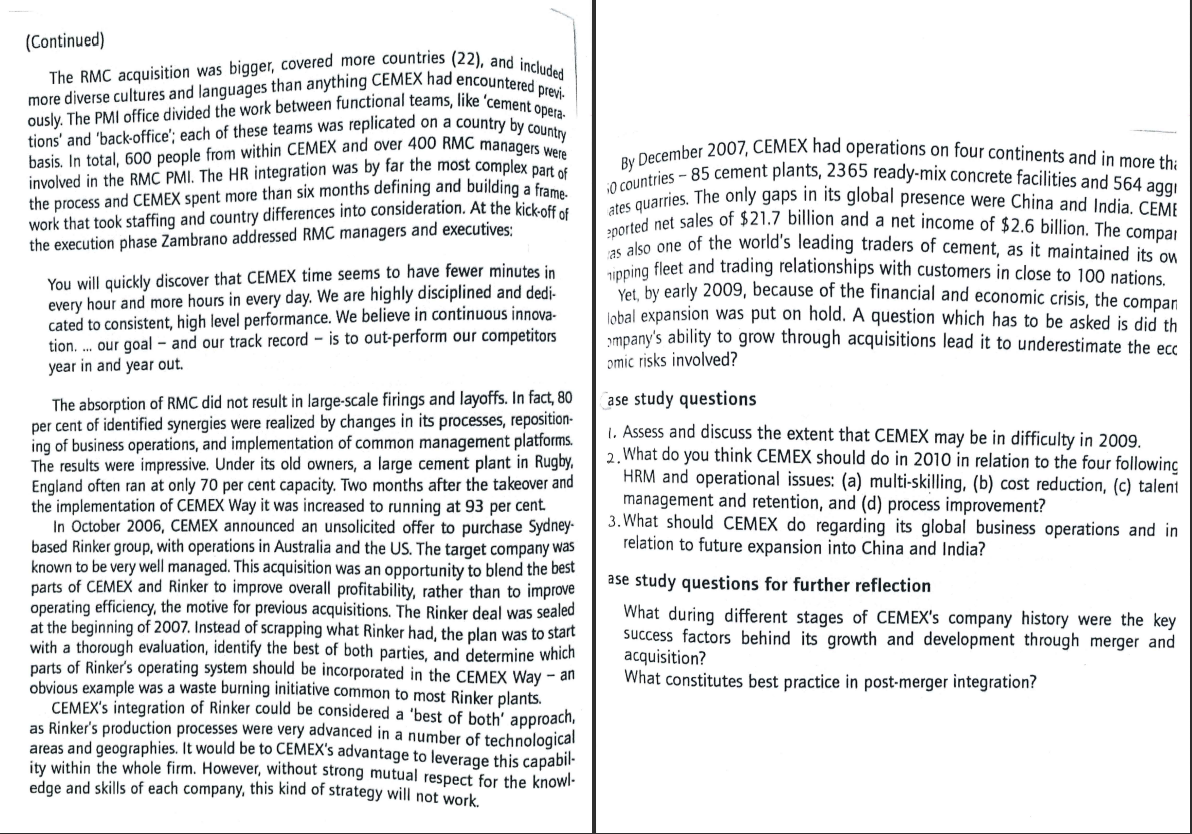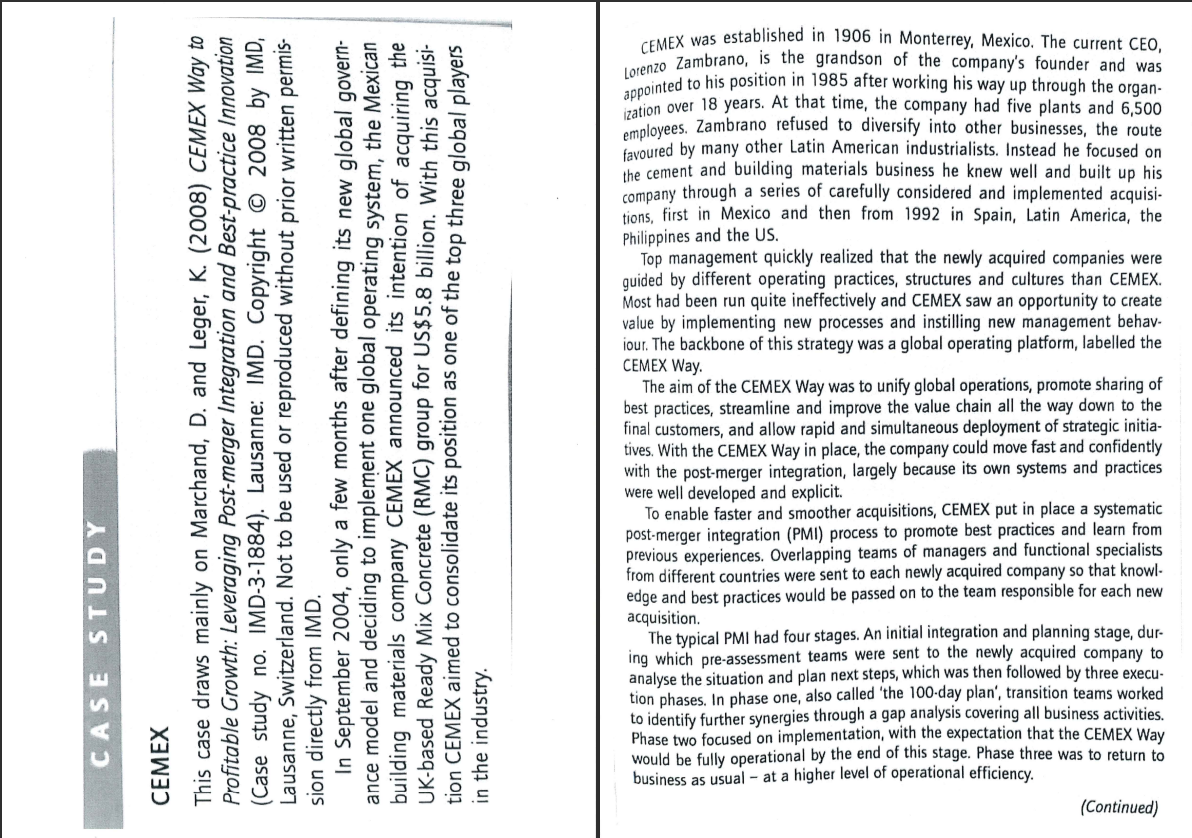Based on the case study in the picture, my assigned question is what should CEMEX do regarding its global business operations.
Based on the case study in the picture, my assigned question is what should CEMEX do regarding its global business operations.
Practical Management Science
6th Edition
ISBN:9781337406659
Author:WINSTON, Wayne L.
Publisher:WINSTON, Wayne L.
Chapter2: Introduction To Spreadsheet Modeling
Section: Chapter Questions
Problem 20P: Julie James is opening a lemonade stand. She believes the fixed cost per week of running the stand...
Related questions
Question
Based on the case study in the picture, my assigned question is what should CEMEX do regarding its global business operations.
I would appreciate if you could provide me with some points. Thank you.

Transcribed Image Text:basis. In total, 600 people from within CEMEX and over 400 RMC managers were
ously. The PMI office divided the work between functional teams, like 'cement opera-
more diverse cultures and languages than anything CEMEX had encountered previ-
The RMC acquisition was bigger, covered more countries (22), and included
By December 2007, CEMEX had operations on four continents and in more thi
ates quarries. The only gaps in its global presence were China and India. CEME
i0 countries - 85 cement plants, 2365 ready-mix concrete facilities and 564 aggi
2ported net sales of $21.7 billion and a net income of $2.6 billion. The compai
(Continued)
tions' and 'back-office'; each of these teams was replicated on a country by coera-
involved in the RMC PMI. The HR integration was by far the most complex par
the process and CEMEX spent more than six months defining and building a frame
work that took staffing and country differences into consideration. At the kickoff et
the execution phase Zambrano addressed RMC managers and executives:
You will quickly discover that CEMEX time seems to have fewer minutes in
every hour and more hours in every day. We are highly disciplined and dedi-
cated to consistent, high level performance. We believe in continuous innova-
tion. . our goal - and our track record – is to out-perform our competitors
year in and year out.
po ko one of the world's leading traders of cement, as it maintained jts on
inping fleet and trading relationships with customers in close to 100 nations.
Vet hy early 2009, because of the financial and economic crisis, the compan
lobal expansion was put on hold. A question which has to be asked is did th
smpany's ability to grow through acquisitions lead it to underestimate the ecc
omic risks involved?
The absorption of RMC did not result in large-scale firings and layoffs. In fact, 80
per cent of identified synergies were realized by changes in its processes, reposition-
ing of business operations, and implementation of common management platforms.
The results were impressive. Under its old owners, a large cement plant in
England often ran at only 70 per cent capacity. Two months after the takeover and
the implementation of CEMEX Way it was increased to running at 93 per cent.
In October 2006, CEMEX announced an unsolicited offer to purchase Sydney-
based Rinker group, with operations in Australia and the US. The target company was
known to be very well managed. This acquisition was an opportunity to blend the best
parts of CEMEX and Rinker to improve overall profitability, rather than to improve
operating efficiency, the motive for previous acquisitions. The Rinker deal was sealed
at the beginning of 2007. Instead of scrapping what Rinker had, the plan was to start
with a thorough evaluation, identify the best of both parties, and determine which
parts of Rinker's operating system should be incorporated in the CEMEX Way – an
obvious example was a waste burning initiative common to most Rinker plants.
CEMEX's integration of Rinker could be considered a 'best of both' approach,
as Rinker's production processes were very advanced in a number of technological
areas and geographies. It would be to CEMEX's advantage to leverage this capabil-
ity within the whole firm. However, without strong mutual respect for the knowl-
edge and skills of each company, this kind of strategy will not work
(ase study questions
1. Assess and discuss the extent that CEMEX may be in difficulty in 2009.
2, What do you think CEMEX should do in 2010 in relation to the four following
HRM and operational issues: (a) multi-skilling, (b) cost reduction, (c) talent
management and retention, and (d) process improvement?
3. What should CEMEX do regarding its global business operations and in
relation to future expansion into China and India?
ase study questions for further reflection
What during different stages of CEMEX's company history were the key
success factors behind its growth and development through merger and
acquisition?
What constitutes best practice in post-merger integration?

Transcribed Image Text:appointed to his position in 1985 after working his way up through the organ-
TMEX was established in 1906 in Monterrey, Mexico. The current CEO,
CE Zambrano, is the grandson of the company's founder and was
ration over 18 years. At that time, the company had five plants and 6,500
employees. Zambrano refused to diversify into other businesses, the route
favoured by many other Latin American industrialists. Instead he focused on
the cement and building materials business he knew well and built up his
company through a series of carefully considered and implemented acquisi-
tions, first in Mexico and then from 1992 in Spain, Latin America, the
Philippines and the US.
Top management quickly realized that the newly acquired companies were
guided by different operating practices, structures and cultures than CEMEX.
Most had been run quite ineffectively and CEMEX saw an opportunity to create
value by implementing new processes and instilling new management behav-
iour. The backbone of this strategy was a global operating platform, labelled the
CEMEX Way.
The aim of the CEMEX Way was to unify global operations, promote sharing of
best practices, streamline and improve the value chain all the way down to the
final customers, and allow rapid and simultaneous deployment of strategic initia-
tives. With the CEMEX Way in place, the company could move fast and confidently
with the post-merger integration, largely because its own systems and practices
were well developed and explicit.
To enable faster and smoother acquisitions, CEMEX put in place a systematic
post-merger integration (PMI) process to promote best practices and learn from
previous experiences. Overlapping teams of managers and functional specialists
from different countries were sent to each newly acquired company so that knowl-
edge and best practices would be passed on to the team responsible for each new
acquisition.
The typical PMI had four stages. An initial integration and planning stage, dur-
ing which pre-assessment teams were sent to the newly acquired company to
analyse the situation and plan next steps, which was then followed by three execu-
tion phases. In phase one, also called 'the 100-day plan', transition teams worked
to identify further synergies through a gap analysis covering all business activities,
Phase two focused on implementation, with the expectation that the CEMEX Way
would be fully operational by the end of this stage. Phase three was to return to
business as usual - at a higher level of operational efficiency.
(Continued)
CASE STUDY
CEMEX
This case draws mainly on Marchand, D. and Leger, K. (2008) CEMEX Way to
Profitable Growth: Leveraging Post-merger Integration and Best-practice Innovation
(Case study no. IMD-3-1884). Lausanne: IMD. Copyright © 2008 by IMD,
Lausanne, Switzerland. Not to be used or reproduced without prior written permis-
sion directly from IMD.
In September 2004, only a few months after defining its new global govern-
ance model and deciding to implement one global operating system, the Mexican
building materials company CEMEX announced its intention of acquiring the
UK-based Ready Mix Concrete (RMC) group for US$5.8 billion. With this acquisi-
tion CEMEX aimed to consolidate its position as one of the top three global players
in the industry.
Expert Solution
This question has been solved!
Explore an expertly crafted, step-by-step solution for a thorough understanding of key concepts.
This is a popular solution!
Trending now
This is a popular solution!
Step by step
Solved in 2 steps

Recommended textbooks for you

Practical Management Science
Operations Management
ISBN:
9781337406659
Author:
WINSTON, Wayne L.
Publisher:
Cengage,

Operations Management
Operations Management
ISBN:
9781259667473
Author:
William J Stevenson
Publisher:
McGraw-Hill Education

Operations and Supply Chain Management (Mcgraw-hi…
Operations Management
ISBN:
9781259666100
Author:
F. Robert Jacobs, Richard B Chase
Publisher:
McGraw-Hill Education

Practical Management Science
Operations Management
ISBN:
9781337406659
Author:
WINSTON, Wayne L.
Publisher:
Cengage,

Operations Management
Operations Management
ISBN:
9781259667473
Author:
William J Stevenson
Publisher:
McGraw-Hill Education

Operations and Supply Chain Management (Mcgraw-hi…
Operations Management
ISBN:
9781259666100
Author:
F. Robert Jacobs, Richard B Chase
Publisher:
McGraw-Hill Education


Purchasing and Supply Chain Management
Operations Management
ISBN:
9781285869681
Author:
Robert M. Monczka, Robert B. Handfield, Larry C. Giunipero, James L. Patterson
Publisher:
Cengage Learning

Production and Operations Analysis, Seventh Editi…
Operations Management
ISBN:
9781478623069
Author:
Steven Nahmias, Tava Lennon Olsen
Publisher:
Waveland Press, Inc.